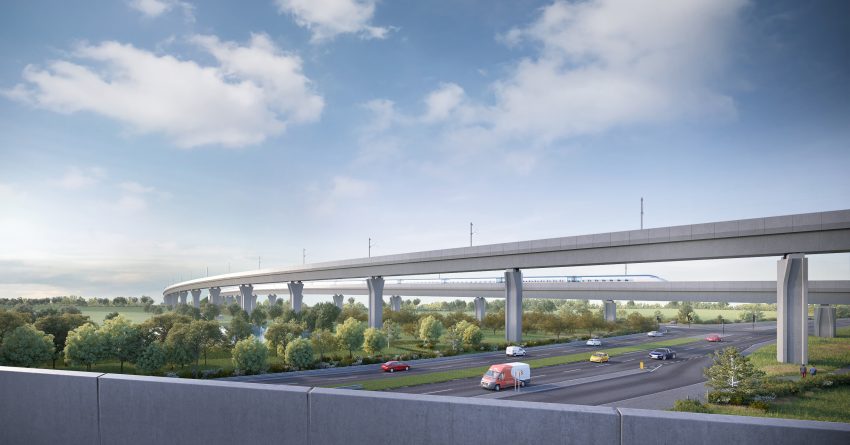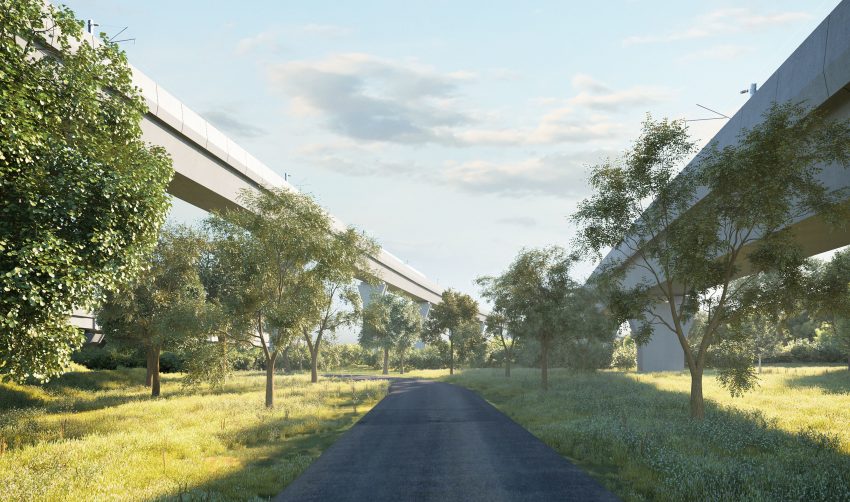As a result, HS2’s landscape architects and engineers from Systra and Mott MacDonald working closely with architects Weston Williamson + Partners and Lavigne Chéron have developed new plans for a more connected and accessible area that will include tree planting and new wildlife habitats with an opportunity, subject to local interest, for a community orchard or area of allotments.
The section of the HS2 route where the two Water Orton viaducts are located is known as the Delta Junction, a triangular section of line where the new railway curves west towards Birmingham and runs north towards Crewe and beyond. The Water Orton viaducts link the curve that heads west towards Birmingham with the main line heading north, and are needed in this location to carry the railway across a network of existing motorways, roads and footpaths.
Our approach at Water Orton has been to design structures which are in constant dialogue with the landscape, in parts screened and concealed by vegetation and elsewhere emerging into clearings, creating bold and dramatic views. The team has worked hard to elegantly sculpt these viaducts into the most narrow and slender structures possible, with large spans which reduce the number of piers. This minimises the locations where the structure touches the ground, improves the sustainability performance of the viaducts, and also creates opportunities for new green spaces and community amenities.
The area between the two Water Orton viaducts, which was previously the site of the Old Saltleians Rugby Club, will be re-designed to provide bigger, better more joined up habitats such as species rich grasslands and native species tree planting. Improved connections through the Delta Junction area will be developed with new paths and cycle routes set within a nature rich corridor.
The new landscape design will provide a new setting for the viaducts which are designed with slim support piers to enhance their design and reduce shading of the areas over which the railway will pass.
HS2’s main works civils contractor BBV (Balfour Beatty Vinci) will build this section of the railway, and have also revealed plans to minimise construction impacts in the area. This includes creating HS2 haul roads for transporting material to avoid the need to use local roads, and construction work on the site will also be kept to a minimum by manufacturing the segments of the viaducts in a factory outside the area. BBV have also committed to using up to 60% sustainable alternatives to cement in the construction of the structures.
"HS2 will not only provide a greener way to travel, it also creates an opportunity to enhance the natural environment along the route through our landscape design. We are committed to bringing out the character of the landscape, to create areas where people can connect to their local environment and enjoy nature.
We’re pleased to have a committed, multidisciplinary team of engineers, architects and landscape architects working on the project, to support ways to create integrated structures and new green spaces for people to enjoy. As we develop the detailed design for the railway, we are listening to feedback from communities like Water Orton, and also continue to work with them and local authorities to explore further opportunities for local connectivity through pedestrian access and cycling routes."
HS2’s Design Director Kay Hughes

"Our goal for the landscape design around Water Orton is to tie the proposed viaduct structures into the local landscape and create opportunities to enhance it. We propose to recreate woodland blocks and frame hedgerows to conserve the agricultural character of the area. There are also plans to re-meander an existing water course and take advantage of the land under the viaducts in a sustainable way. These new designs protect existing habitats and connect them with newly created areas, and the impact of the railway is reduced through planting that will integrate HS2 into the local environment."
Maxime Corlay, Landscape Architect at Systra
